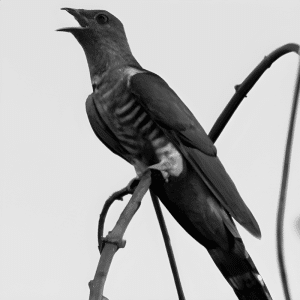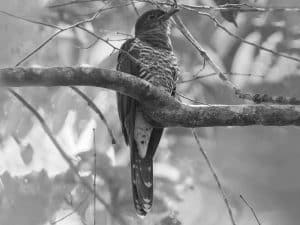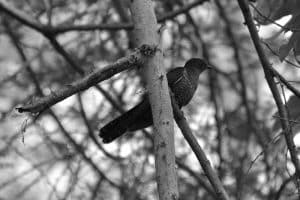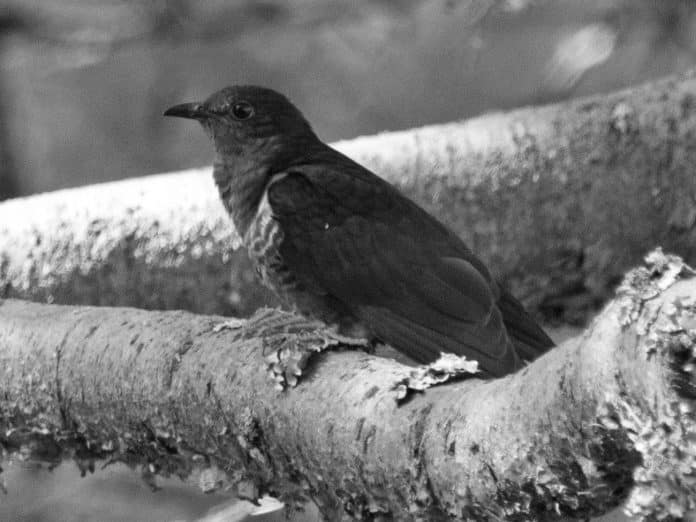Introduction to the black cuckoo in Tanzania
The black cuckoo (Cuculus clamosus) is a fascinating bird species that can be found in Tanzania, East Africa. With its dark plumage and distinctive call, the black cuckoo in Tanzania is a stealthy songster that often goes unnoticed in the shadows of the forest. In this article, we will explore the physical characteristics, habitat, breeding behavior, diet, migration patterns, conservation status, and interesting facts about the black cuckoo. We will also provide tips for spotting and observing this elusive bird in Tanzania, as well as recommend birdwatching locations where black cuckoo sightings are more likely.
Physical characteristics and habitat of the black cuckoo

The black cuckoo is a medium-sized bird, measuring around 30 centimeters in length. It has a glossy black plumage, which allows it to blend well with the shadows of the forest. The male and female black cuckoos have similar appearances, with the male having a slightly larger size. The black cuckoo also has a long tail, which aids in its agility while flying through the dense vegetation.
This species of cuckoo can be found in a variety of habitats in Tanzania, including forests, woodlands, and savannahs. It prefers areas with dense vegetation and tall trees, where it can find suitable nesting sites and a variety of insects to feed on. The black cuckoo is known to be a solitary bird, often staying hidden among the foliage, which makes it challenging to spot and observe in the wild.
Breeding behavior and nesting habits of the black cuckoo
The black cuckoo is a brood parasite, which means it lays its eggs in the nests of other bird species. The female black cuckoo carefully selects a suitable host nest, typically belonging to a smaller bird species. Once the host nest is identified, the female cuckoo removes one of the host eggs and replaces it with her own. This behavior ensures that the black cuckoo chick will receive priority in terms of food and care from the unwitting host parents.
The black cuckoo’s eggs mimic the appearance of the host eggs, reducing the chances of detection. The host parents will incubate the cuckoo egg and raise the chick as their own. The black cuckoo chick grows rapidly, often outcompeting the host chicks for food. This unique breeding behavior allows the black cuckoo to maximize its reproductive success without the need for building its own nest or raising its own young.
Diet and feeding habits of the black cuckoo

The black cuckoo primarily feeds on insects, such as caterpillars, beetles, and grasshoppers. It hunts for its prey by silently perching on a branch, patiently waiting for an opportunity to swoop down and catch its target. The black cuckoo has a long bill, which it uses to probe into crevices and extract insects from their hiding places. It is also known to consume small reptiles and amphibians on occasion.
Unlike some other cuckoo species, the black cuckoo does not rely on a specific host species for its food supply. It is a generalist feeder and can adapt to various prey availability in its habitat. This flexibility in its diet allows the black cuckoo to survive and thrive in different environments, making it a successful and widespread species in Tanzania.
Migration patterns and seasonal movements of the black cuckoo
The black cuckoo is a migratory bird, spending the breeding season in Tanzania and then embarking on a long journey to its wintering grounds in southern Africa. The exact migration patterns of the black cuckoo are still being studied, but it is believed that they follow a southward route, crossing various countries along the way. They are known to pass through Malawi, Zambia, and Zimbabwe during their migration.
During the non-breeding season, the black cuckoo seeks out warmer climates with abundant food resources. It spends several months in its wintering grounds before returning to Tanzania for the breeding season. The timing of their migration is influenced by factors such as food availability and weather conditions. These seasonal movements allow the black cuckoo to exploit different habitats and maximize its chances of survival and successful breeding.
Conservation status and threats to the black cuckoo population
The black cuckoo is currently classified as a species of least concern by the International Union for Conservation of Nature (IUCN). However, like many bird species, it faces various threats to its population. Habitat loss and fragmentation due to deforestation are significant concerns for the black cuckoo. The destruction of its preferred forest habitats reduces the availability of suitable nesting sites and food sources.
Additionally, climate change may have an impact on the black cuckoo’s migration patterns and timing. Changes in temperature and weather patterns could disrupt the timing of food availability and affect the success of breeding and survival rates. It is crucial to monitor the population trends and habitat conditions of the black cuckoo to ensure its long-term conservation.
Interesting facts and myths about the black cuckoo

The black cuckoo has inspired many myths and legends across different cultures. In some African folklore, the black cuckoo is believed to possess magical powers and is often associated with rain and abundance. Its distinctive call is said to bring good luck and prosperity. However, these myths are purely based on cultural beliefs and do not have any scientific basis.
One interesting fact about the black cuckoo is its ability to mimic the calls of other bird species. It is known to imitate the calls of other birds to confuse potential predators or to attract mates. This mimicry is a remarkable adaptation that helps the black cuckoo survive and thrive in its environment.
Tips for spotting and observing the black cuckoo in Tanzania
Spotting and observing the black cuckoo can be a rewarding experience for birdwatchers in Tanzania. However, due to its elusive nature, some strategies can increase your chances of a sighting. Firstly, familiarize yourself with the black cuckoo’s call, as it is often heard before it is seen. The call is a distinctive series of clear, descending notes. By listening for the call, you can narrow down the search area.
Secondly, look for areas with dense vegetation and tall trees, as these are the preferred habitats of the black cuckoo. Scan the lower branches and undergrowth for any movement or dark shapes that could indicate the presence of the bird. Patience and persistence are key when searching for the black cuckoo, as it may take time to spot it among the shadows of the forest.
Recommended birdwatching locations in Tanzania for black cuckoo sightings
If you are specifically interested in observing the black cuckoo in Tanzania, there are several birdwatching locations that are known for their black cuckoo sightings. Some recommended locations include the Udzungwa Mountains National Park, the Eastern Arc Mountains, and the Selous Game Reserve. These areas offer a combination of suitable habitats and diverse bird species, increasing your chances of encountering the black cuckoo.
Conclusion: Appreciating the beauty and mystery of the black cuckoo in Tanzania
The black cuckoo is a remarkable bird species that adds to the biodiversity of Tanzania. Its stealthy nature and elusive behavior make it a challenge to spot and observe, but with patience and perseverance, it is possible to catch a glimpse of this fascinating songster in the shadows. By understanding its physical characteristics, habitat requirements, breeding behavior, diet, migration patterns, and conservation status, we can appreciate the beauty and mystery of the black cuckoo. Let us continue to protect and conserve the habitats that support this remarkable species, ensuring its survival for future generations to admire and enjoy.


































